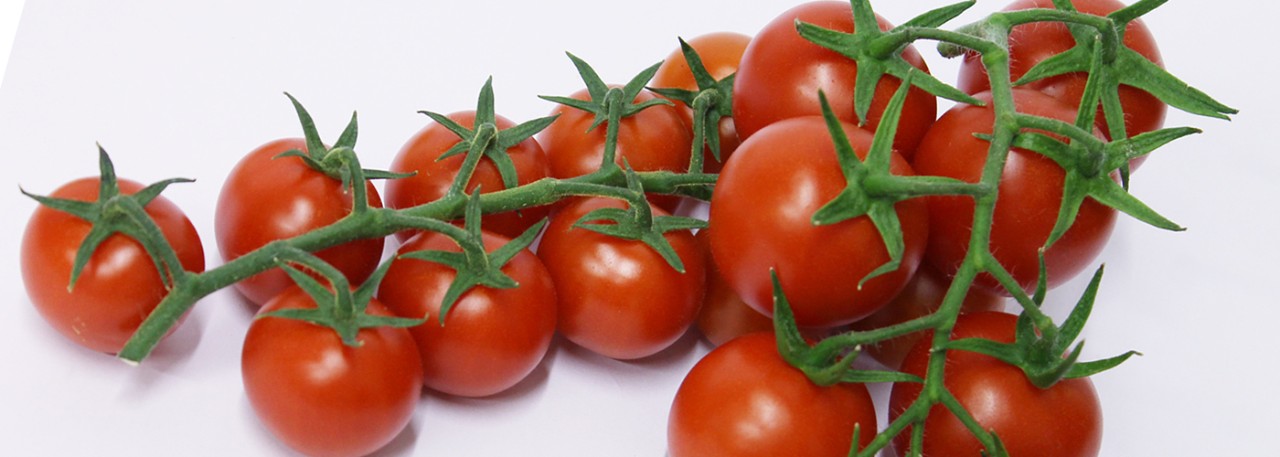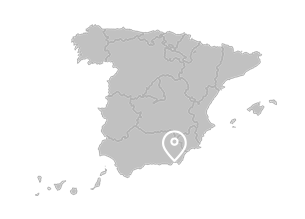.png.transform/rendition-xs/image_image%20(1).png)
Tomate La Cañada PGI
The tomato fruit, (Lycopersican esculentum Mill.) from the Redondo Liso (Round Smooth), Asurcado (Ribbed), Oblongo o Alargado (Oblong or Elongated) and Cereza (Cherry) Tomato varieties. They come from a dicotyledon plant belonging to the Solanaceae family.
Tasting notes
-Round Smooth Variety: These are tomatoes that have a strong and very dark colour, good flavour, are very consistent and preserve well with a 47 mm to 102 mm calibre.
-Cherry Tomato Variety (including Cocktail): These are round and elongated fruits with an intense red colour and are very delicious and aromatic. The diameters that are marketed range from 20 to 35 mm.
-Ribbed Variety These are ribbed, uniform tomatoes that have a dark colour and a very intense green neck along with an excellent favour and extreme sweetness. The calibres they are marketed with have diameters of 47 to 82 mm.
-Oblong or Elongated Variety: These are very uniform fruits with an ovoid shape and intense red colour. These tomatoes are consistent, have a mild flavour, fine skin and fleshy texture. They are distinguished from other varieties by their less acidic flavour.
Other notes
Physical-chemical characteristics of the four types of La Cañada Tomato:
- Total sugar content of between 1,000-3,500 mg/100 g with an average content of 1,600 mg/100 g.
- Organic acid content from 250-600 mg/100 g with an average content of 350 mg/g. Firmness between 1-2 Kg/cm2.
Carotene content (Lycopene) between 1,000-4,000 micrograms per 100 grams except for the ribbed varieties. This high lycopene content that occurs in three out of the four existing commercial types of La Cañada Tomato is responsible for their intense red colour.
Production / Processing method
The La Cañada Tomato crops need protective structures as part of their conditions for cultivation and production. Regarding the predominant covering type, the traditional vine type (flat) and multi-span (ridge and furrow), representing approximately 70% of the surface in the cultivation area of the La Cañada Tomato. Therefore, these are protected crops whose structures cause a reduction of the water needs, wind speed and damage from pests, diseases, nematodes, weeds, birds and other predators; protection of the crop from low temperatures. At the same time in these structures, the impact of arid and desert climates is mitigated, taking advantage of solar energy more efficiently and improving quality, preserving present resources.
The cultivation techniques used are in compliance with the previously cited regulation: UNE 155.102, Fresh produce.
Obtaining seeds: the seed is obtained through seed businesses or a point of authorised sale. It is taken to a professional seedbed, authorised by the official bodies, where, 30 days before for cultivation in sand in the summer, and 40 days in the winter, the seed is grown in individual root balls for cultivation in the ground. After planting, the substrate is moistened and the trays are moved to a germination chamber with conditions of 25ºC, 90% humidity and darkness for three days to be later extended in cultivation, guaranteeing minimum temperatures over 12ºC in the winter through heating.
Final seating of the crop. The drip irrigation system is placed according to the frame, density and orientation of the plantation. Normally, the orientation of the crop line is from North to South to facilitate the entrance of light and prevent shadows in the winter months, when the angle of incidence of solar radiation is very low. In the sand, the holes are opened and labour is done to move the sand and manure until reaching the land, guided by the drippers. The plant can be placed in the ground or placed on it, protecting it with sand. Formative pruning: This is one of the cultivation techniques that are applied to the tomato plant. The small, axillary shoots called buds are removed because in their development, they produce lateral shoots, leaves and flowers or fruits. The de-leafing or pruning of the axillary shoots is started when inflorescence is observed in the majority of the plants.
The removal or pruning of senescent leaves is done as the plant needs, it to facilitate aeration and improve the colour of the fruits. When the plants have acquired excessive vigour, the leaves are thinned, especially if they overlap and do not allow the fruits to be seen. The inflorescences are cut back or the flowers or fruits are pruned, which entails removing them when there are too many and also the removal of recently shaped fruit with deformities. Through this process, the calibre increases and the homogeneity and quality of the remaining fruits is obtained, along with a reduction of damaged fruit. After the first pruning, the plants are hilled or buried again.
Training: The plants are then fastened, which is an essential practice in cultivation of the tomato from this geographical area. Its purpose is to keep the plant upright to prevent contact with the ground, which will bring about problems with diseases and the quality of the fruit, as well as decreases in production. As the plant grows, it is tied or fastened with to the training string using rings until the plant reaches the wire, which occurs in the long cycle in the first months of winter. Irrigation, fertilisation, pest and disease control, harvest and transport: These are carried out according to the indications included in the UNE 155.102 standard applicable to tomatoes.
The harvest of the product on the farm depends on the variety, but in no case is its harvest permitted before the fruit has started the process of commercial maturation in the field. This is done manually by the farmer, who places the tomatoes in plastic boxes (15 kg capacity) to later be palletised and transported to the horticultural centre. Good cultivation practices, knowledge of the factors of production and the environment (water, soil, solar radiation, natural ventilation, etc.) are the origin of the special nature of the La Cañada Tomato. Phases of the production process: The handling operations are done separately depending on the product. There is a complete differentiation of the batches at the horticultural centre through the use of coloured boards, spatial separation in the lines between them, etc. depending on each company.
The duly identified product is stored in the warehouse area established for such purpose where it awaits its incorporation into the handling chain. The batches of controlled product (batches of product that fit the indication) remain stored separately from batches of non-controlled product.
Once in the calibrator, the tomato (round smooth, ribbed and oblong or elongated) goes through a pre-selection process in which the tomatoes whose calibre is equal to or greater than 47 mm are separated from those whose is not. The tomatoes with a lesser calibre are moved to be sorted and those equal to or greater than 47 mm go to the phase for calibration by colour and weight.
Labelling: The commercial labels and back labels from each registered company must be approved by the Regulatory Council. The name of the Geographical Indication must mandatorily appear in an emphasised manner on the labels and back labels of the packaged tomato.
Geography / Relief and climate
From a general point of view, the demarcated geographical area is included in the area classified as arid (ixósera curve of 3 to 6) and sub-desert based on its climate. That is, we are in the most arid part of Europe, characterised by absence of frost and such scarce rainfall that you could even say arid desert. This aridity is characterised by light rain, the average annual rainfall being between 200 and 400 mm, by a high average annual temperature between 16.8 and 18.3ºC and by a great evaporating power of the atmosphere.
The rainfall is characterised by its torrential nature as well as by its monthly and yearly irregularity. These natural conditions together with the hydrogeological characteristics of the area explain the absence of surface waters, which is why it is absolutely necessary to use underground hydraulic resources.
This high average annual temperature combined with the low average annual rainfall ensures there will be a strong evapotranspiration and little drainage, which allows the soluble salts to stay in the soil and elevate its electrical conductivity. Part of the climate characteristics of the demarcated area are the result of the general atmospheric circulation which determines the peninsular climate but at the same time, it is also determined by the relative position that the area occupies in the Spanish territory - in the southeast corner - therefore in the furthest away position from the air masses that contribute to the formation of the peninsular climate and furthermore, the area is strongly influenced by the great African desert.
All of this is combined with the local conditions, with the area walled in to the North by significant mountainous masses such as the Sierra Nevada and the Sierra de los Filabres and further South by the Sierra Alhamilla and the Sierra Cabrera, as well as by the Sierra de Gador to the West, all of which isolate the area from the northern influences and the winds from the West and the North, thus joining the position of the area with the Mediterranean Sea to the South and East.
As a consequence, this location leeward of the northern air masses, along with its latitude and the influence from the Mediterranean Sea, gives the region exceptional thermal conditions. The average annual relative humidity is 73% due to a great regularity of humidity year round. This relative humidity does not produce condensation, therefore the area is characterised by its scarcity of foggy days.
Regulatory Council
Consejo Regulador de la IPG Tomate La Cañada
Carretera de Ronda 11 - Bajo
04004 Almería
Andalucía
Tel.: (+ 34) 950 280 380
igp@elprimertomate.com
miguelangel@elprimertomate.com
www.elprimertomate.com
Sources:
The only tomato in Spain which holds a denomination of origin.


- /content/dam/en/icex-foodswines/images/products/fruits---vegetables/tomate-la-cañada-pgi/Tomate%20La%20Cañada%20PGI%20carr1.jpg
- /content/dam/en/icex-foodswines/images/products/fruits---vegetables/tomate-la-cañada-pgi/Tomate%20La%20Cañada%20PGI%20carr2.jpg

Almería (Andalusia)
